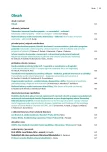-
Medical journals
- Career
Possible endoscopic solutions of polypoid and non-polypoid lesions in the colon
Authors: Milan Dastych; Radek Kroupa
Authors‘ workplace: Interní gastroenterologická klinika LF MU a FN Brno, pracoviště Bohunice, přednosta prof. MUDr. Aleš Hep, CSc.
Published in: Vnitř Lék 2015; 61(7-8): 698-702
Category: Vanýsek´s day 2015
Overview
Colorectal cancer (CRC) is one of the most frequent malignant diseases in the Czech Republic. Almost 70 % of CRC develop based on adenomatous polyps, 30 % arise de novo. The pathogenesis of development of colorectal cancer confirms an adenoma to carcinoma sequence, based on the gradually developing mutations of oncogenes and suppressor genes. By removing the adenomatous mucosal neoplasia the pathway of CRC development is cut off, which is the practical goal of the screening programme. To meet the goals of the preventive programme the gastroenterologists performing endoscopy must be appropriately trained and experienced in the detection of and procedures of removing mucosal neoplasias. Surface mucosal neoplasias are morphologically divided based on the Paris and Japanese classification into 2 basic types: protruding type I, whose height is greater than 2.5 mm above the level of the surrounding mucous membrane, and flat type II, whose height is smaller than 2.5mm. We have the following procedures available for endoscopic removing of surface mucosal lesions: loop polypectomy, endoscopic mucosal resection and endoscopic submucosal dissection. The choice of method depends on the lesion morphology. Benign mucosal lesions (adenoma, hyperplastic polyp) can only be treated endoscopically. Non-invasive malignant mucosal lesions limited to mucosa can also be treated endoscopically, invasive cancers penetrating into submucosa (malignant polyp, T1N0M0) are treated based on the definitive histological finding, and on meeting Morson’s criteria the endoscopic removal can be seen as curative. The problem of flat malignant mucosal lesions is more complex and in most cases, when cancerous cells penetrate into submucosa, endoscopic resection cannot be performed and surgical solution follows.
Key words:
EMR – ESD – polypectomy – mucosal neoplasia – colon
Sources
1. Kliment M, Falt P, Fojtík P et al. Endoskopická diagnostika a liečba povrchových kolorektálnych neoplázií. Endoskopie 2009; 18(4): 150–155.
2. The Paris endoscopic classification of superficial neoplastic lesions: esophagus, stomach and colon: November 30 to December 1, 2002. Gastrointest Endosc 2003; 58(Suppl 6): S3-S43.
3. Suchánek Š, Vepřeková G, Májek O et al. Epidemiologie, etiologie, screening a diagnostika kolorektálnho karcinomu, včetně diagnosticko-terapeutických zákroků na tlustém střevě. Onkologie 2011; 5(5): 261–265.
4. Národní program screeningu kolorektálního karcinomu v České republice. Zpráva o sběru dat prostřednictvím elektronického registru za rok 2013. Institut biostatistiky a analýzy MU. Informace dostupné z WWW: <http://www.iba.muni.cz>.
5. Mařatka Z et al. Gastroenterologie. Grada: Praha 1999. ISBN-10 : 80–7184–561–2.
6. Rejchrt S. Editorial. Gastrointestinal epithelial neoplasia. We can see only what we already know. Folia Gastroenterol Hepatol 2004; 2(4): 143–146.
Labels
Diabetology Endocrinology Internal medicine
Article was published inInternal Medicine

2015 Issue 7-8-
All articles in this issue
- Pancreas transplantation: State of the art and future prospects
- Tumours and liver transplants
- Solid organ transplantation in the Czech Republic
- Cannabis – therapy for the future?
- New trends in treatment of non-variceal bleeding in the upper gastrointestinal tract
- Home nutrition care in the Czech Republic
- Vitamin D – old substance in new perspectives
- Possible endoscopic solutions of polypoid and non-polypoid lesions in the colon
- Ordinary disease – appendicitis
- Platí „LDL-hypotéza“ i pro pacienty s diabetem?
- Lowering of blood pressure – by treatment of other risk factors
- How to treat dyslipidemia in patients with metabolic syndrome
- AB0 incompatible kidney transplantation – first experiences
- Takotsubo cardiomyopathy – what has changed – editorial
- Risk factors of thyroid carcinoma – editorial
- Takotsubo cardiomyopathy, clinical experience with the disease and one-year prognosis of patients
- Rituximab infusion-related toxicity in patients with chronic lymphocytic leukemia
- Cardiovascular effects of GLP-1 receptor agonist treatment: focus on liraglutide
- Transcatheter aortic valve implantation – diagnostic, procedure and outcomes
- Hepatorenal syndrome – pathophysiology, diagnosis and treatment
- Risk factors of thyroid carcinoma
-
Erectile dysfunction as the first sign of systemic vascular diseases and of organovascular arterial ischemic diseases.
Guidelines and Challenge of the Angiology section of Slovak Medical Chamber (AS SMC, 2015)
- Internal Medicine
- Journal archive
- Current issue
- Online only
- About the journal
Most read in this issue- Ordinary disease – appendicitis
- Transcatheter aortic valve implantation – diagnostic, procedure and outcomes
- Hepatorenal syndrome – pathophysiology, diagnosis and treatment
-
Erectile dysfunction as the first sign of systemic vascular diseases and of organovascular arterial ischemic diseases.
Guidelines and Challenge of the Angiology section of Slovak Medical Chamber (AS SMC, 2015)
Login#ADS_BOTTOM_SCRIPTS#Forgotten passwordEnter the email address that you registered with. We will send you instructions on how to set a new password.
- Career

